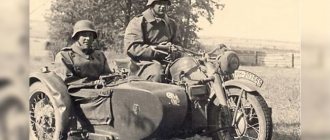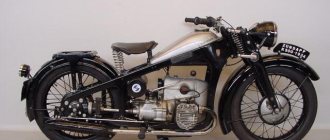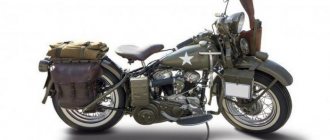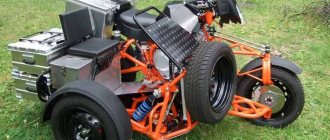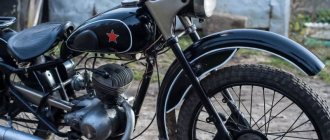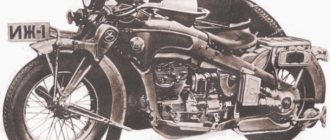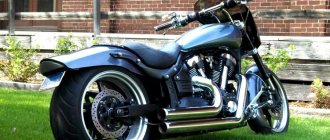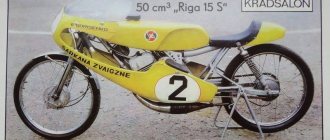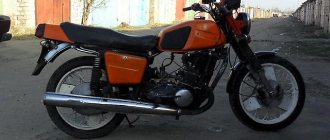The production of motorcycles in Germany began in pre-war times. After the peace treaty was signed, the Germans were prohibited from producing various types of weapons, but motor vehicles were not included in this list. This marked the dawn of the motorcycle industry in Germany. At that time, a car was considered a luxury item, but anyone could buy a regular moped. Companies such as BMW and Zundapp took an active part in the creation of two-wheeled units.
At first, the boxer engine did not stand out in any way against the background of foreign units. However, already in 24, the company independently assembled the first production bike, the BMW R32 . True, the time of motorcycles for general use quickly exhausted its need, and already in the 30s the concern began to produce military motorcycles. The first vehicle specialized in military needs was the BMW R35. This was the first German military motorcycle of the Bavarian company, which had a telescopic fork in front and a 398 cc engine. Low wear and tear during use made this bike indispensable for military purposes. Production lasted about 10 years, after which it gave way to narrow specialization.
In addition to the 35th model, there was also a 12th model. It was an improved version with a larger 750 cc engine. and hydraulic suspension. Removing one carburetor reduced power by 2 horsepower. In 1935, 35 thousand of these units rolled off the assembly line. Low cost and good performance ensured the popularity of this model. In addition, the ability to install the stroller satisfied the needs of many owners. In addition to standard modifications, springs were installed to transport people wounded in battle.
Then the 71st model , which became the basis for the creation of the Soviet Ural and Dnepr motorcycles. The production began in 1938 and was active for a couple of years, after which the unjustification of costs forced the owners to close the project. The equally popular company Zundapp created cheaper bikes with sidecars. Due to their price and maneuverability, they became the basis of the German army's weapons. The most popular model, the K800, was the only model with a four-cylinder engine. This system was rather problematic because it did not provide sufficient cooling to the last two cylinders. This made using the bike for a long time impossible, in addition, the spark plugs often became oily and jammed during operation.
The Great Patriotic War and military motorcycles
German motorcycles of the Second World War consisted of only two models - the BMW R75 and the Zundapp KS750. They performed well off-road and produced good power. Both units had all-wheel drive; we put strollers on the wheel. But the cost of these models did not allow the use of the equipment in Germany. Therefore, all produced equipment was sent from the assembly line to foreign buildings. This continued from 1940 to 1942. Then the decision came to release a modified version of the KS750 with a trailer from BMW . True, the model was never produced in mass production, since the previous order from the state for 40,000 copies of models with a sidecar was not fully completed, stopping at the production of approximately 17,000 mopeds.
Throughout the war, the Germans produced a motorcycle with caterpillar tracks. Such an innovation was surprising not only for opponents, but also for Germany itself. The model was called Kettenkrad and was produced for five years, during which about 8.5 thousand such devices were created. Due to the installed tracks, the bike's cross-country ability in the most difficult conditions was significantly increased. True, when turning, the equipment often turned over, while the driver did not have time to jump due to the difficulties of landing. Moreover, the significant weight of the unit did not allow it to climb the slopes in a diagonal trajectory.
Like all German motorcycles of the Second World War, the Kettenkrad had a large engine with a volume of one and a half liters. True, in appearance such a device was more reminiscent of a small infantry fighting vehicle than a motorcycle. It was convenient to transport people. I was also pleased with the ease of control, albeit with minor shortcomings, but for a bike with such dimensions the idea was very good. The Wehrmacht tracked motorcycle, with all the abundance of iron cover, weighed quite a bit - only 325 kilograms. For a 1.4-liter engine that produced 26 horsepower, such a mass did not cause any particular problems.
German units made a great impression not only on Soviet manufacturers. After the war, many foreign analogues of the BMW R71 model were created. For example, Harley borrowed BMW's four-speed gearbox and driveshaft drive to the rear of the motorcycle.
Wehrmacht Zundapp motorcycle from Germany
Today in Russia, Belarus, Ukraine and even Kazakhstan there is a certain layer of collectors who have many rare bikes and are constantly adding new items to their collection. Most of them are in particular demand for such a German WWII motorcycle as the “Zundapp”. Moto KS 750 is a striking analogue of the German motorcycle “BMW R-75”. Both bike brands once collaborated on the design of two- and three-wheeled vehicles.
Both of the above German motorcycles were specially developed for almost all types of Wehrmacht troops. Most of the components and spare parts of these two models were interchangeable.
The German Zundapp motorcycle experienced its baptism of fire back in 1939. It was then that the Wehrmacht began to occupy Poland. The main supply of motorcycle equipment to the German army was carried out by factories in Munich (BMW) and Nuremberg (Zundapp). It is noteworthy that before the war Germany did not hesitate to purchase foreign bikes, for example, Triumph and Victoria. Among the transport equipment of the fascist troops were Ardie, NSU, and DKW motorcycles. With the beginning of the war, all civilian motorcycles were subject to mass confiscation from the population on German soil.
Modern German motorcycles
Many of you have already learned from friends/acquaintances or seen for yourself in practice that the best German motorcycle is, of course, a BMW motorcycle.
Most recently, the Bavarian transport company presented its “R 1200 RT” at world motorcycle shows, which is truly the ideal police bike. With the endowed power, the above iron horse is capable of catching up with any average offenders. The created prototype will go on production line in 2014, and then it will receive considerable demand from the executive authorities of many European countries and beyond.
Such German motorcycles from BMW Motorrad are equipped with special technical means in the form of flashing beacons and a siren. They even added a walkie-talkie to this bike. It, along with the loudspeaker, was placed in the rear center case.
In recent years, sales of German BMW motorcycles have also increased in the American market, where the marketing press has still not turned off. Moreover, every year more and more Americans prefer motorcycles from Germany.
- Back
- Forward
BMW R75
The German tracked motorcycle was not the brightest vehicle of the Second World War. This title rightfully went to the BMW R75 unit. The boxer engine with two cylinders and valves located in the upper part made a splash in the engine industry. The ignition system was equipped with automatic stabilization of the spark advance angle. Despite its considerable weight, the bike was quite maneuverable and passable. In addition, the excellent performance indicators provided by the 750 cc engine. allowed the motorcycle to easily accelerate and pick up speed up to 90 km/h.
The reason for the ease of control was the drive not only to the rear of the motorcycle, but also to the sidecar wheel. Moreover, for comfortable movement in cold climates, the floor of the stroller was equipped with a heating system. The driver was warmed by an air supply system from the engine.
At that time, mobile operations carried out by the German army could not be imagined without this unit. The BMW R75 was in service with various Wehrmacht formations. Everyone rode them - from infantry troops to landing troops.
In addition to excellent cross-country ability, the unit boasted good load capacity. Even with passengers, the device could pull a 450-kilogram trailer, for example, anti-tank installations or mortars. We can say that the BMW R75 is a universal German motorcycle of the 2nd World War. It served not only to transport officers and equipment, but was also used as a communications or reconnaissance vehicle. There were motorcycle companies, consisting of almost 65% of such units.
The device weighed about 660 kilograms with an attached stroller. This made it one of the heaviest motorcycles of its time. Oddly enough, such weight had little effect on cross-country ability. In addition, it was very stable and maneuverable while driving. The fuel consumption was also surprising. In standard configuration, without installing an additional gas tank, the R75 could travel 340 kilometers without refueling.
In conclusion, we can say that the systems installed on German military motorcycles began to be in great demand. Soviet analogues of the BMW R75 are still used in rural areas of our country and even on city streets.
First models
The owners decided to start producing vehicles. The first motorcycle, the Tsundap Z22, was introduced in 1921. It was quite in keeping with the spirit of the times. From a technical point of view, the motorcycle did not shine with anything special, but it was capable of accelerating to 65 km/h, while consuming less than a liter of gasoline. What else do you need in a crisis? Soon the line was replenished with the Z2G model, which has slight differences from the prototype.
Since 1924, the company began producing motorcycles with a chain drive (before that there was a belt drive), and in 1927, cargo trikes were added to the line. Even with the onset of the Great Depression, which undoubtedly affected the German economy, the manufacturer developed new models, introduced innovations, increased production capacity and remained afloat. A significant role was played by the company's policy aimed at constantly improving the reliability of manufactured vehicles. At the same time, Tsundap has always tried to maintain a loyal price level.
Competent management, constant market analysis, and focus on consumer demand also contributed to success. For example, as a result of the crisis, a new product appeared in the Tsundap line - the K170 motorcycle, the smallest and most economical in the entire history of the company. Along with its production, a project was launched to produce large, heavy bikes with four-stroke engines. To achieve this, the company signed a cooperation agreement with English colleagues. The result was the release of several models with Python engines.
Touches to the portrait
The advance of Nazi Germany across Europe led the Wehrmacht command to the idea of the need for a small and mobile vehicle that would be equally successful on any terrain. The answer was the R75 three-wheeled motorcycle sidecar manufactured by BMW. The transport proved to be fast, flexible and extremely suitable for off-road use.
The German army used the BMW R75 in all theaters of war: from the desert of North Africa to the impassable mud of the Eastern Front. Despite the fact that the motorized stroller weighed quite a lot when equipped, more than 400 kg, the engine capacity was 750 cc. see allowed the “device” to accelerate to almost 100 km/h.
To ensure safety and reliability, BMW engineers equipped all three wheels with brakes. Moreover, the rear wheel brakes were hydraulic, and a mechanical brake was installed on the front wheel. The motorcycle had a cardan drive with a four-speed gearbox, of which three were intended for forward movement, one provided reverse gear.
The design made it possible to tow a light gun
The design of the sidecar initially made it possible to pull out a light artillery piece, but the crew increased the versatility and combat value of the R75 by installing a machine gun.
From August 1942, the Wehrmacht tried to simplify the production process. The generals insisted that BMW and its rival Zundapp standardize their parts and develop a single hybrid model. We agreed to start the project after the production of the BMW R75 reaches 20,200 units. However, before this point, Allied bombers destroyed the plant in Eisenach. As a result, BMW was able to produce only 16,510 R75 sidecars.
Performance characteristics of BMW R75
BMW R75 in desert camouflage
| Places | 3 |
| Dimensions (with stroller), mm | 2400x1730x1000 |
| Wheelbase, mm | 1444 |
| Engine | gasoline, carburetor, four-stroke, two-cylinder, opposed, overhead valve BMW type 275/2 |
| Working volume, cm cubic. | 745 |
| Power, hp/revolutions per min. | 26/4400 |
| Curb weight. kg | 670 |
| Speed range, km/h | from 3 to 95 |
| Fuel consumption l/100 km | 9 (on the highway) |
It all started with a bicycle
At the beginning of the 19th century, the popularity of the bicycle in Europe grew at a frantic pace - more and more people were interested in this means of transportation, and societies uniting cycling enthusiasts appeared. Gradually, inventors began to think about modernizing the design and creating a self-propelled bicycle. One of the first to add a steam engine to two wheels was the French technician Louis-Guillaume Perrault, who filed a patent for his model in 1869. However, his steam bicycle was too bulky, and the speed - a maximum of 15 kilometers per hour - left much to be desired.
A few years later, in Germany, experiments on the creation of a gasoline internal combustion engine were carried out by Gottlieb Daimler and Wilhelm Maybach. Interestingly, the invention of the motorcycle was not the ultimate goal of the German inventors - they sought to create a four-wheeled carriage using their gasoline engine. They were able to implement their idea already in 1886. And a year before that, they introduced a device that is considered the first motorcycle. The invention was called Daimler Petroleum Reitwagen, which translates from German as “Daimler’s kerosene riding cart.” Daimler's son Paul was the first to test it.
The ideas of Daimler and Maybach were developed by another duo of German inventors - Henrik Hildebrand and Alois Wolfmüller, who in 1894 introduced the first production motorcycle. Hildebrand and Wolfmüller improved the creation of their predecessors - with an empty tank, their motorcycle weighed only 50 kilograms and could accelerate to 45 kilometers per hour. At first, their company was quite successful - by the end of 1894, the plant was producing 10 motorcycles a day, and they quickly sold out. However, the success soon faded: new buyers began to be put off by the high price of the unit. In addition, during operation, some technical imperfections were revealed: the motorcycle was unstable and difficult to control. Some of the firm's clients have been involved in accidents, resulting in lawsuits. By 1897, motorcycle production had completely stopped. According to modern estimates, in three years Hildebrand and Wolfmüller managed to produce about two thousand cars.
People from the Russian Empire also contributed to the development of the motorcycle. Brothers Mikhail and Evgeniy Werner, who moved to France in 1891, began working on their version in 1896. A year later they released the first model to the market. In just a few years, the brothers managed to assemble more than three thousand motorcycles. In 1901, they presented to the public a new model that could be called revolutionary.
A significant change was made to the design of the motorcycle: the engine was installed not on the front of the frame, but between two wheels. The Werner brothers' products were popular both in Europe and America. This success allowed them to begin producing cars in 1906.
Yes, they forgot about the ravines...
Reality, as usually happens, made its own adjustments: until the war with the Soviets, the Nazis were never able to test motorcycles in a real combat situation.
The annexation of countries such as Austria, the Czech Republic, the Sudetenland and Moravia took place quickly and bloodlessly. The only trouble that “Krauts on motorcycles” encountered in Europe was rain and wind. The roads were excellent.
The war in France revealed only positive aspects. The roads were still excellent, and it turned out that evacuating the wounded on motorcycles was very effective. After the capture of France and Belgium, many French and Belgian motorcycles fell into the hands of the Nazis, which were also going to be used in the army.
Wehrmacht motorized units also operated successfully in Poland. Here they first entered into a real battle with the enemy, and in addition, in the Tukholskaya Pushcha they had to overcome real off-road conditions, but still the motorcyclists managed to show their best side: the weather was favorable for this - it was dry.
However, in Poland the first “bell” sounded - Kampinovskaya Pushcha and the sands around the city of Kielce turned out to be impassable for motorcyclists - without a wheelchair, motorcycles got stuck in the sand. In addition, the operation of light motorcycles with an engine capacity of 250 - 300 cc failed. They could not bear the load, often broke down, and required careful handling and frequent maintenance. They could only be used by messengers at headquarters, since they had time for maintenance.
First World War
The first attempts at military use of bicycles in Germany began in 1892. Cyclists were used as messengers and scouts. And already in 1894, the first bicycle divisions were created.
By the beginning of the First World War, each German Jaeger battalion had a scooter company. In total there were 36 bicycle divisions. By the end of the war, there were already about 80 scooter companies in the German army.
Read also: Double, openwork and “frivolous”: 5 bicycles with “oddities”
The Germans believed so much in the massive use of “two-wheeled troops” that they even began to create a special “anti-bicycle” weapon: they trained huge Great Danes, teaching them, on command, to pounce on people riding a bicycle (as a bicycle was often called then) and overturn them to the ground.
Scooters of the First World War
Bicycle patrol 1914
Bicycle regiment on the Western Front in 1914
Cyclist squad in the Ardennes. 1914
Cyclists in full equipment. 1915
Scooter with folding bike. 1916
FN M12
The FN company in Liege has been selling civilian motorcycles to the Belgian army since the First World War. Following the release of the M86 in 1936, the Belgians decided to develop a model specifically for military use.
FN M86 Super Sport 1937. Civilian version of the FN M12 model
The M12 was significantly better than the M86. It was equipped with a sidecar with machine gun mounts at the front and rear. A more powerful engine compared to the base model drove both the rear wheel and the sidecar wheel. Thanks to the presence of reverse gear, the motorcycle could maneuver well even in small spaces.
CZ 175
This is one of several similar motorcycle models created for the Czechoslovak army in the 1930s. The single-seater CZ 175 was not powerful at all - it was rather designed as a lightweight, maneuverable model that could be easily controlled even on rough terrain. Only the front wheel had suspension.
Model 1939 CZ 175

